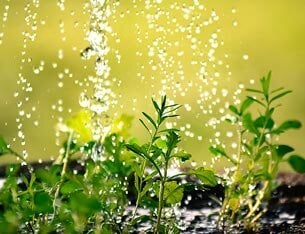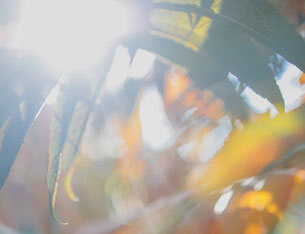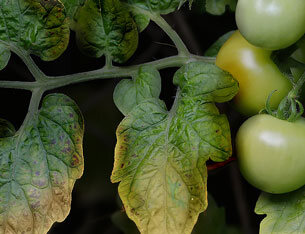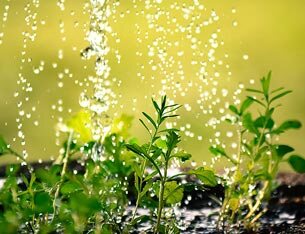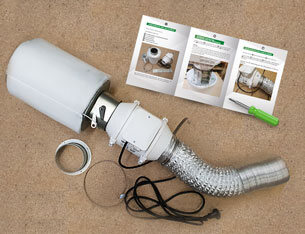Water is life, and of course that also applies to your plants in the grow box. So water regularly, but how much and how often, and when is the best time to water, and which water do I use?
These and other questions are answered on this page.
Because by watering your plants correctly, you can contribute a lot to their healthy development and significantly increase your yields.
How much to water?
The first and probably most important question when watering your plants revolves around the frequency of watering and the right amount of water. Of course, you don't want your grow to dry out, but waterlogging in the root zone is almost more dangerous.
The basic rule is: the soil should always be moist, but never wet. You can easily tell by the weight of the pots.
The temperature in your grow room or grow box also plays an important role in this context. In a hot environment, the plants naturally need more water, also because a large part is excreted through evaporation via the leaves. (If evaporation through the leaves is high, the plants also need less fertiliser).
Other important influencing factors are the size of the plant and its stage of development (seedling, growth, flowering), as well as the size of the pots you use for your grow.
The structure of your grow soil or substrate also influences the optimal amount of watering. It is also important how well the drainage of the root area works, i.e. how quickly or slowly the water runs off again. (If water collects in the saucers, this should be drained off quickly, otherwise bacteria can easily form).
Our Growmart tip in the blog: How to successfully switch from soil to coco
Water your grow every day?
Rather not. The frequency of watering depends on the specific water needs of your plants and not on fixed intervals.
How often you need to water your grow, in turn, depends very much on the size of the plants and pots as well as the amount and structure of the substrate used. (If you HAVE to water every day, this is an indication that the pots are too small: time to repot).
The soil should already be really dry (not completely parched, of course) before watering, because the plant needs oxygen as well as water for healthy growth. In this context, our Air-Pots or fabric pots offer a very good and oxygen-rich alternative.
The best thing to do is to lift the pot before watering and note the weight before watering, because dried soil has almost no weight. As soon as you have developed a feeling for this weight, you can estimate the water requirements of your plants very well.
Tip: Very dry soil does not absorb the water directly, but lets it run through. Therefore, first moisten the soil a little and then water it "properly" a short time later.
Drain watering
If you have to water your grow every two days, you can water the plants wet, or until the water runs out of the bottom of the pot. (Drain watering)
The plants then seem to have a higher demand and draw both water and the equally vital oxygen.
If you only have to water every 3-4 days, then your pots may be oversized and you should use better fitting pots for the next grow or grow the plants larger accordingly. (Especially when the plant goes into flowering, the available area should be well rooted to ensure the best possible nutrient supply).
Of course, not all plants need the same amount of water either. Therefore, it is recommended to lift all pots individually and water the plants according to their needs.
The genetics of your plants also influence their thirst. If you grow a new variety, it may drink differently than the old ones. Always remember: your third grow is your first grow.
The best time to water
It is best to water your grow in the morning, or in the first hours of light. The chemical processes of plant growth start with the (sun) light and the plant gets enough water for this. Watering in the evening hours or at the end of the lighting phase should be avoided, as it significantly increases the risk of waterlogging or root rot.
Your watering water should ideally have a temperature of around 20° Celsius.
Watering your grow with tap water?
When watering your beloved plants, it is of course not only about the right amount and the right time, but also about the right water.
If you water with tap water, it depends on where you live and the hardness of the water in that area. Tap water can also be contaminated, especially in cities and conurbations. (Tip: Google your water company or call and ask about the specific values for your tap water).
In the best case you should use filtered water, for example from a reverse osmosis system, because it allows you to adjust the pH and EC values very precisely to the needs of your plants. With a stable pH and EC value, your plants can also absorb many more nutrients.
Some growers also water their plants with rainwater, which is not necessarily better than tap water. When watering with rainwater, food-grade tanks should be used at best.
Observe pH-value and EC-value
When watering your plants, you should also pay attention to the pH value and the EC value of the water used.
Tap water often contains more chlorine than the plants can tolerate, while the pH value is often 8 to 8.5. However, your plants need a neutral to slightly acidic soil. Water with a pH value of 6.5 is therefore recommended for watering.
We recommend buying a meter for the pH value as well as for the EC value.
Our Growmart tip in the blog: Measuring and correcting the pH value
Seedlings, cuttings, growth, flowering
Of course, the stage of development of your plant also plays a certain role in watering.
For seedlings without roots it is very important that the soil is always moist, because they will die quickly at the slightest dryness. But here, too, the soil must never be too wet, because the seedlings will be attacked by mould if there is too much water. Instead of a watering can, we recommend using a sprayer to moisten the soil. As soon as the seedlings have developed a root system, you should switch to a watering can.
When the roots are strong enough, it is important to let the soil dry out a little before the next watering.
Especially in the phase of root growth, mould growth is increased; short dry periods counteract this.
In the vegetative phase of plant life, it is important to water the soil slowly and evenly. If watering is too fast, water channels form in the soil through which the water then runs out without really moistening the soil.
In the flowering phase the plant generally uses more water than in the growing phase, but towards the end of flowering the water requirement decreases. Otherwise, the same principles apply for sufficient, not excessive watering.
Recognising and correcting problems when watering plants
You will quickly be able to see the mistakes that are made when watering from the plants. Incorrect watering can be seen on the leaves, on the stems and also on the roots.
The most common mistake is over-watering. If the soil gets too much water, important air pockets are moistened and the plants cannot absorb enough oxygen.
The plant's growth slows down, leaves turn yellow, become dull or fall off. Roots discolour or smell rotten. If this is the case, the soil must dry out again by itself until the roots of the plant have recovered. You can recognise this by the strong white roots that are soaked with water.
If watering is inadequate, first the soil and then the roots will dry out. The plant stops growing. The plant first draws on its own reserves until its cells are empty. Then the plant no longer manages to stand upright until finally the cells die.
Suddenly lighter leaves, drooping, shrivelled or wilting leaves are signs of possible underwatering.
You can rehydrate dried out plants by placing them in a tub filled with water and watering from above. This will slowly increase the moisture level of the soil and restore the original capacity to store water.
Hydroponics and watering
In a hydroponic system, watering is of course different from growing on soil. Unlike wet soil, the roots are continuously supplied with oxygen.
Watering is done by an automatic system five to ten times a day. Plants in a hydroponic system are always watered "wet", a total of 20% more than the plants need at any one time.
The remaining water flows through the medium and flushes out old, excess nutrients with it.
Grow flush or rinse
Two weeks before harvesting, you should flush your grow to wash out all minerals and nutrients from the soil. Flushing forces the plant to use up all the nutrients left in the plant.
Before rinsing your grow, be sure to measure the pH and adjust it to 6.5-7 if necessary. Then water the soil or pot generously, wait 10 minutes and then water again.
Flood your grow as long and often as necessary until it has an EC value of no more than 50 ppm.
Grow Proper Watering Summary
When watering, you should say goodbye to the old principle of "a lot helps a lot". Overwatering is a bigger and more frequent problem than underwatering your favourites.
Above all, there is no fixed rule for all plants and every grow room. The climatic conditions in your grow room or grow box are crucial for the water requirements of your plants, plus of course the quality of the water you use for watering.
